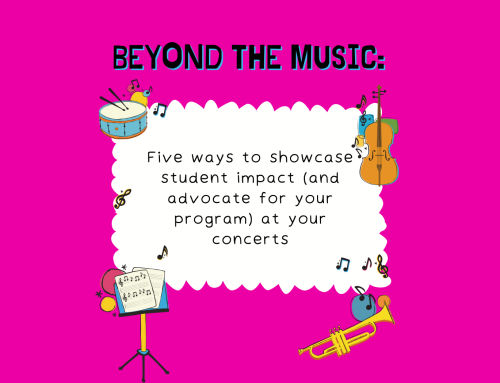In this installment of Growing Young Professionals, we will be talking about Human Resource Management! So, what is HRM? Most young professionals have heard of a Human Resources (HR) department, but not many have interacted with one. Most large scale organizations (school districts, businesses) have an HR department that supports employees. When you apply for a job at a school, you will almost always contact the school’s HR department, which handles the initial steps of the hiring process (reviewing resumes, checking backgrounds). Once you accept a position, the department will walk you through your next steps. To learn more about Human Resources in education, I interviewed David Hastings Ed. D, the Program Coordinator for Fine Arts in the Cecil County Public Schools and Dr. Jenny Neff, director of the MM in Music Education & Summer Music Studies Programs at the University of the Arts.
Question: I just got hired; what are my next steps?
Both Dr. Hastings and Dr. Neff agree that there is a “to-do” list after getting hired.
Dr. Neff: “After you sign your contract, you may be contacted by the HR department with onboarding information. Many districts require new teachers to attend orientation days as part of this onboarding process so that you can get acclimated to district policies, procedures, focus areas, and information.
Additionally, you will contact your building administrator and your supervisor if there is one in the district. They will provide your teaching schedule, make arrangements for you to see and start organizing your teaching space, and provide other important information.
Most districts will assign a mentor who can help answer questions and share information on various topics. Your mentor can be a music or non-music teacher. Your music department colleagues will become an important part of your “new job family.” Don’t be afraid to get to know other faculty members as soon as you can, so you start to become part of the school community and build a support system.”
Dr. Hastings also acknowledges that the initial process will include signing contracts and choosing a health insurance package. He points out that this process may not happen immediately and lays out three steps you can take in the meantime:
- “Meeting with your new school administrators to take a tour of your school and classroom.
- Meet with the Content Coordinator to receive curriculum and other information.
- Meet with new colleagues.”
In short, MEET new people. Getting a new job is becoming part of a new community. The best way to serve your students and the community as a whole is to get in touch with your new environment, including the people with whom you will be working.
Q: How do pay scales work? How do I read a pay scale?
Dr. Hastings notes, “pay scales come in all ‘shapes and sizes.’” He also provides general guidelines:
- “At the top of the payscale, look for the appropriate School Year and for “Teacher.” Since contracts can be muti-year, it is important to first look for the one you need.
- The scale will look like a chart. Look for the appropriate fiscal year. If you are a new teacher, you start at “Step 1” If you have experience, you will negotiate with Human Resources on which step you begin. Then also look for the degree and certificate which you hold.”
Dr. Neff provided further detail:
“A teacher pay scale looks like a grid (or matrix). There are numbers listed vertically that represent each “step” or year of teaching that is completed. Horizontally, you will find the salary differentials. The more credits you earn after your bachelor’s degree, the more columns you move across the grid. Many salary scales/grids include columns for bachelor’s; bachelor’s + 15; bachelor’s + 30; master’s; master’s + 15; master’s + 30; master’s + 45; doctorate. These increments will vary among districts – some will have more or fewer columns. Each district should have their salary posted in the contract – typically on the final pages.”
Q: I want to go to graduate school; what is typically my best course of action?
Dr. Hasting discusses personal reasons for seeking graduate education. “It is important to figure out why you want to go to graduate school. Sometimes, it is to “delay the inevitable” of finding a career. Other times, it’s to get a Master’s in Teaching due to their Undergraduate degree being in music performance, etc.
If graduate school is an interest, seek guidance from the institution you are attending and start looking in your junior year of college. If you are waiting until you begin teaching, you can contact Human Resources about programs that are available as well.”
Dr. Neff discusses logistics on the topic. “Check your teacher contract to see if your district has tuition reimbursement.” When talking about benefits specifically, Dr. Neff noted, “Some districts offer tuition reimbursement as a benefit. More and more districts have stopped offering this, so you will want to read your contract to learn if they do and how tuition reimbursement works. There can be variations on approved institutions, approved programs or courses, the number of credits per year, the percentage covered, what grade you receive, and the amount of money set aside for this purpose, to name a few.”
If your district does offer tuition reimbursement, “you will want to read all of the details and plan accordingly. Many states require teachers to earn a certain number of continuing education credits to keep their teacher certification active. If you enroll in graduate school, be sure your credits count towards those hours. Some states also require a master’s degree to continue teaching, so you will want to explore your options to meet your professional needs and goals.”
Q: What is the point of benefits? How do they work?
Dr. Hastings focuses on types of benefits and their purpose. “Benefits provide additional enhancements to your job over your salary. These include a few different categories:
- Fringe Benefits Medical, Dental, and Vision Healthcare, Term Life-Insurance, Liability Insurance, Flexible Spending Plan (allows you to put money away each paycheck for a big healthcare expenditure that is not going to be fully covered) Tuition Reimbursement, etc., options for Tax Shelter Annuities
- Leave: this includes paid time off of work for many reasons: Sick Leave, Personal Leave, Family Bereavement, Religious Holidays, Sabbatical, Legal Summons, other leave of absences.
- Programs: Wellness program, Employee Assistance Program (free personal and professional counseling if you have personal/professional problems that interfere with your job).”
Dr. Neff discusses benefits in relation to daily life. “Benefits vary depending on where you work, but they often include benefits for the employee (self), and you can add additional family members for a cost. Most benefit packages include medical, vision, and dental. You will receive insurance cards that you present at your medical appointments. If you have a portion to pay, you will pay this at the time of the appointment or be billed after the appointment. You will want to check your “explanation of benefits” information to find out what services are covered (fully, partially, or if at all).
Benefits also include any time off (illness, family leave, death in the family, maternity, child-rearing, sabbatical, personal days).”
Q: How do I read a benefits package and determine which option is best for me? (Please include the addition of spouses and dependents).
Dr. Hasting explains, “Usually, healthcare options are broken down into three options: Single household: 2-member (you and your spouse); Family plan (you, spouse and children). The best first step is to speak to a colleague, spouse, parent about these decisions. They will be able to help guide you. When reading a benefit plan and choosing the appropriate healthcare, you have to consider your health and your spouses and dependents’ health. Some plans offer more coverage but are more expensive. If you or members of your family require more doctor visits or specialized care, it is worth choosing the more expensive option.”
To this, Dr. Neff adds, “You will also be able to see how much each option costs. There may be a choice in plans – some require you to go to certain doctors in a network and/or obtain a referral from a doctor. You might also have options to participate in flex spending or health savings accounts that have tax advantages, in saving for certain health care costs.”
So what?
The Human Resource Department will be your contact for employment logistics throughout your time with a school district or business. They are there to provide clarity and assistance; most importantly, they are there to help growing professionals! Staying informed is the best way to prepare for the future.
Special thanks to Dr. David Hastings and Dr. Jenny Neff for being GYP’s inaugural interviewees; your knowledge will keep us informed and help us grow!




Leave A Comment